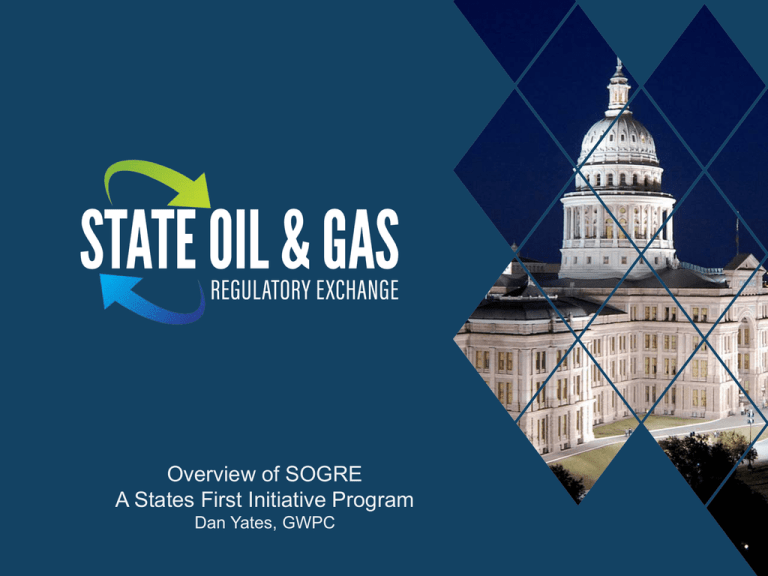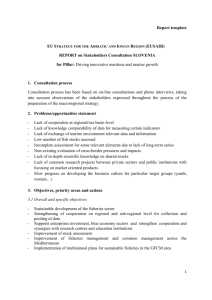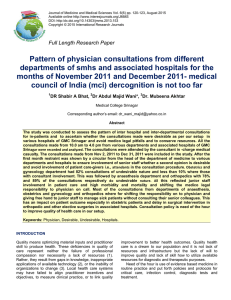Overview of SOGRE A States First Initiative Program Dan Yates, GWPC
advertisement

Overview of SOGRE A States First Initiative Program Dan Yates, GWPC Mission The STATE OIL AND GAS REGULATORY EXCHANGE (SOGRE) is an outreach program created under the Ground Water Protection Council (GWPC) and Interstate Oil and Gas Compact Commission (IOGCC) States First Initiative. The mission of the SOGRE is to assist states to continually improve state oil and gas regulatory programs by providing member states consultation and program review services targeted to their specific needs. Provided Services Regulatory Consultations • Facilitate consultations between member states, drawing on the expertise of regulatory peers in other states, to assist States in developing regulatory approaches to address a specific issue. • Facilitate the convening of stakeholder forums and workgroups, to share business practices, technical expertise and findings, internal operations, and other matters of common interest to facilitate communication and integration of effective practices from one state to another. Regulatory Assessments • Assist States in developing rule revisions to address a particular issue by providing a peer review of an individual regulation, specific regulatory initiative or an overall program. • Assessments may vary in scope from specific regulatory elements, such as wellbore integrity, to comprehensive reviews of a State’s entire regulatory program. • The Exchange and the State determine relevant regulatory elements for each review. • The State may elect to publish the results of the assessment. REGULATORY CONSULTATIONS Consultation & Assessment Process 1 2 3 4 5 • SOGRE receives official request from State Agency. • SOGRE Staff conducts initial interview with requesting State Agency to define goals, outputs, and outcomes of request. • SOGRE Staff compiles request information and forwards to SOGRE Board for review and approval. • SOGRE Board selects Review Team. • Review Team and SOGRE staff develop customized review questionnaire based on State Agency request and forwards to State Agency. (Continued) Consultation & Assessment Process 6 7 8 9 10 11 • Agency responds to questionnaire. • Review Team assesses questionnaire, conducts further analysis and review as necessary and determines next steps to complete review process. • Review Team completes process and prepares draft report for review by State Agency. • State Agency reviews and provides feedback to Review Team. • Review Team completes Final Report or other types of deliverable as determined by State Agency. • Close Out Meeting – Review Team and State Agency determine next steps, further Agency action items, dissemination of report or deliverables, and feedback to SOGRE on the process. REGULATORY ASSESSMENT Regulatory Assessment Framework Characterization of Objectives Inventory of Evidence Economic Impacts Consistency & Conformance Community Engagement Conservation Capacity for Implementation Characterization of Objectives What regulatory issue is being reviewed? What is the purpose for the creation/change of the regulatory issue? Has the agency identified impacted stakeholders? What is the history of this regulatory issue? How is this regulatory issue expected to evolve? Are other agencies affected or involved in regulating this issue? How does the existing or proposed program meet the agency mission or other relative government initiatives? What is the goal (desired result) of the regulatory response? Inventory of Evidence • What internal analysis of data or other information exists? Has been reviewed? • What external resources exist? Have been reviewed? • Are there evidence-based or science-based reasons for the program, and how are they used? Economic Impacts • Has the agency evaluated the costs of running the program? • Were cost evaluation metrics used? • Has the agency evaluated economic impact to stakeholders? Consistency & Conformance • What processes/controls ensure uniform implementation for the regulated community? • What flexibilities and standards are in place to deal with variability? • Have procedures been established for defining responsibility and authority for handling non-conformance and the taking of corrective and preventative action? Community Engagement • What are the mechanisms for public outreach, participation, and education? • Does the agency have mechanisms in place to promote transparency? Conservation • Does the program help meet the oil and gas production and conservation goals of the agency? • Does the program appropriately protect the environment/public? Capacity for Implementation • What agency resources (human resources, budget, equipment, IT/data, outsourcing) are necessary to implement the program? • Are external resources necessary to implement the program and if so, what steps have been taken to ensure their availability? • Would organizational changes facilitate implementation? Outcomes • What environmental, public, programmatic and protective values are obtained? • How is the program helping minimize risk? • Has the program met expectations? • What metrics or other factors will the agency use to determine the success of the rule relative to the objectives? Continual Improvement • What has been “learned-by-doing” since program inception? • What changes have been achieved? • What are some outcomes that would likely lead the regulator to adjust the rule in the future • Have future challenges been considered? Contact Us www.statesfirstinitiative.org 13308 N MacArthur Blvd., OKC, OK 73142 405.516.4972 dyates@gwpc.org @States1st






